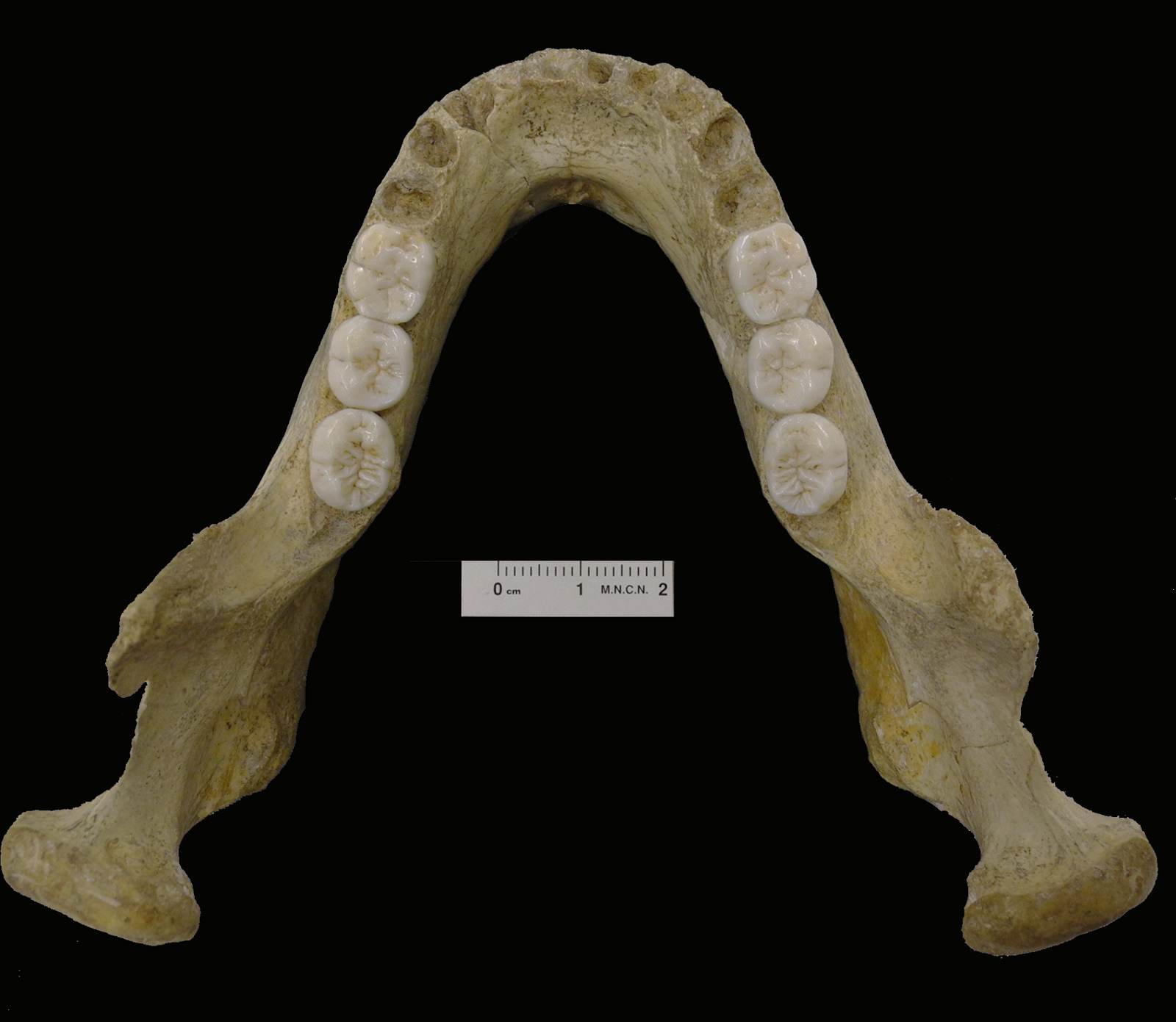 |
| Upper view of the Montmaurin-LN mandible. |
We now know that modern humans interbred with at least two, probably three and possibly more different hominin species when they left Africa. What this new analysis shows is that Neanderthals also interbred with archaic hominins and may not even have formed as single lineage in Eurasia.
Instead, this analysis by a team of scientists from the Centro Nacional de Investigación sobre la Evolución Humana (National Research Centre for Human Evolution - CENIEH) in Spain, led by José María Bermúdez de Castro, together with the French researcher Amélie Vialet, from the Musée d'histoire naturelle (Natural History Museum) in Paris, suggests that Neanderthals may have diversified, evolved as isolated populations, then interbred with one another so that later Neanderthals were a mosaic of earlier and divergent populations.
Interestingly, their analysis shows how our understanding had changed and improved with the addition of more information as more Neanderthal specimens are found.
Abstract
We here present a comparative study of the Montmaurin-LN Middle Pleistocene mandible (Haute-Garonne, France). This mandible, of which its right and left molar series are preserved in situ, was found in La Niche cave (Montmaurin’s karst system) in 1949, and was first attributed to the ‘Mindel-Riss’ interglacial (= MIS 9 to 11) based on its geological context. Later studies based on geological and faunal evidence have attributed the Montmaurin-LN mandible to MIS 7. Following a detailed morphological and metric comparative study of the mandible in the 1970s, it was interpreted in the light of a still limited fossil record and the prevailing paradigm back then. Waiting for geochronological studies in the forthcoming years, here we review the main morphological and metrical features of this mandible and its molars, which have been reassessed in the framework of a remarkably enlarged Pleistocene fossil record since the mandible was first described, and our current, more in-depth understanding of human evolution in Europe. Using a selection of mandibular features with potential taxonomic signal we have found that the Montmaurin-LN mandible shares only a few derived traits with Neandertals. Our analyses reveal that this mandible is more closely related to the ancient specimens from the African and Eurasian Early and Middle Pleistocene, particularly due to the presence of primitive features of the Homo clade. In contrast, the external morphology of the molars is clearly similar to that of Neandertals. The results are assessed in the light of the present competing hypotheses used to explain the European hominin fossil record.
Vialet A, Modesto-Mata M, Martinón-Torres M, Martínez de Pinillos M, Bermúdez de Castro J-M (2018)
A reassessment of the Montmaurin-La Niche mandible (Haute Garonne, France) in the context of European Pleistocene human evolution.
PLoS ONE 13(1): e0189714. https://doi.org/10.1371/journal.pone.0189714
Copyright: © 2018 The authors.
Published open access
Reprinted under the terms of a Creative Commons Attribution 4.0 International License (CC BY 4.0)
Given their apparent propensity to interbreed with other hominins, and given the recreational and social role of sex in addition to procreation in humans, it is not really surprising that Neanderthals and modern humans also interbred when they came into contact. Indeed, it would be more surprising had they not done so.
As this study shows, the human evolutionary story was far from simple and certainly not linear with evolving and diversifying species acting more like a ring species or a super-species with local variants only rarely splitting off to become fully diverged and incapable of interbreeding. For a great deal of our evolution outside Africa we existed as a complex of several contemporaneous, incompletely diversified species, subspecies and regional varieties.
Not only is this evidence of our evolution out of archaic hominids and pre-human and proto-human hominids but that nowhere in that process was there ever anything that could remotely be described as the original humans, not even in terms of an original population.
The emerging picture of human evolution is making the superstitious notions of an original couple changing the relationship with a creator god in a way which we can all be held responsible for, and the idea that modern humans were a special creation, ever more untenable.
The astonishing thing is that there are still people who believe that superstitious model is a better description of reality that the one being revealed by science.
'via Blog this'



Rosa, is this article (and its comments) trustworthy: http://halfsigma.typepad.com/half_sigma/2010/05/evil-neanderthals-raped-human-women.html ?
ReplyDeleteIt's a possible explanation but just one of several. A child of a Neanderthal mother and a modern father would be more likely to be raised as a Neanderthal so her Neanderthal mtDNA wouldn't enter the moderns' gene pool. But of course the Neanderthal female could be a captive enslaved by moderns. It's also possible that the only fertile hybrids were the daughters of Neanderthal fathers and modern mothers. This could explain the lack of Neanderthal Y chromosomes in the present human population. If Neanderthal males had habitually raped modern women you would expect to see Neanderthal Y chromosomes fairly often I would have thought. As one of the comments on the linked article points out, Neanderthal mtDNA could simply have disappeared due to chance.
ReplyDelete